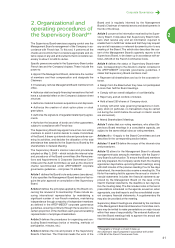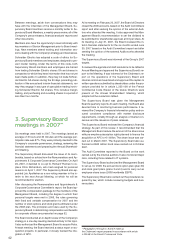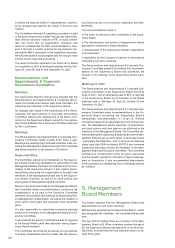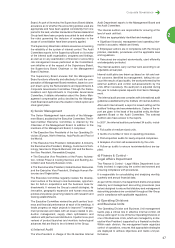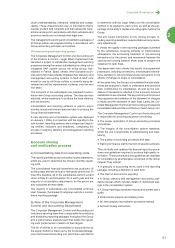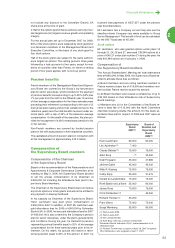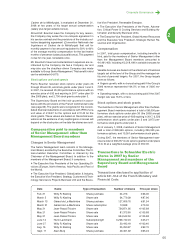APC 2007 Annual Report Download - page 50
Download and view the complete annual report
Please find page 50 of the 2007 APC annual report below. You can navigate through the pages in the report by either clicking on the pages listed below, or by using the keyword search tool below to find specific information within the annual report.48
The Division and Business Unit Executive Vice Presidents
sit on the Executive Committee and report to the Manage-
ment Board Chairman. The financial controllers report to
the Finance & Control - Legal Affairs department. A Man-
agement Committee reviews the transactions of the Divi-
sions and Business Units on a monthly basis.
Thanks to frequent contacts with the corporate functions,
this matrix organization guarantees a high level of respon-
siveness as concerns operations-related risks, through the
presence of local managers, understanding of local envi-
ronments and business models, and effective application
of Group guidelines.
f) Human Resources Department
The Human Resources department is responsible for de-
ploying and ensuring the application of procedures con-
cerning employee development, occupational health and
safety and professional ethics.
These procedures are presented to all employees in a doc-
ument entitled Our Principles of Responsibility. Compliance
is verified through the annual evaluation process and track-
ing of new2indicators (see below).
Internal benchmarks
a) Principles of Responsibility
The Principles of Responsibility are a set of guidelines for
decisions and actions that have an impact on stakeholders
– employees, customers, vendors, shareholders, the com-
munity – or the environment. A copy of the Principles is
given to all new employees along with their employment
contract.
b) Insider Code
This code sets out the rules to be followed by management
and employees to prevent insider trading. It imposes an ob-
ligation of confidentiality on all employees who have ac-
cess to price-sensitive information and sets permanent
restrictions on purchases and sales of Schneider Electric
shares by persons who have access to price-sensitive in-
formation in the course of their work.
c) International Internal Auditing Standards
The Schneider Electric internal auditors are committed to
complying with the international standards published by
the Institute of Internal Auditors (I.I.A.) and other bodies.
d) Statutory and Management Reporting
Principles (see below)
e) AMF Recommended Reference Framework
Schneider Electric has taken measures to align its internal
control system with the reference framework recom-
mended by Autorité des Marchés Financiers (AMF) and
the related application guide.
Procedures
a) Operating procedures
Management of operational risks
As explained above, operational risks are managed first
and foremost by the units in liaison with the Operating Di-
visions and Business Units, based on Group guidelines.
General risks are covered by specific procedures de-
scribed below.
Commitment limits
Commitment limits have been set for executives from
Group level down to the individual units, whereby contracts
for the purchase or sale of products or services may be
signed or authorized only by line management when they
exceed a certain amount which varies according to the
type of contract, the unit and the division, up to a maximum
of €10 million. In addition, all transactions that may affect
the Group’s fundamental interests, due to their size or na-
ture, must be authorized in advance by the Management
Board or, in some cases, the Supervisory Board. This rule
applies in particular to all purchases and sales of shares in
subsidiaries and affiliates whatever the amounts involved,
as well as to subscriptions to share issues by these enti-
ties, purchases and sales of strategic assets, product de-
velopment, trademarks and patents, and off-balance sheet
commitments.
Acquisitions Committee, New Products Committee
Proposed business acquisitions and development pro-
grams must be submitted to the Acquisitions Committee
or the New Products Committee in each Business Unit for
review, prior to being presented for approval at the appro-
priate management level as described above. The two
committees are made up of representatives of the main
departments involved in the projects.
Quarterly management reviews
Group Senior Management (comprising the Chairman of
the Management Board, the Executive Vice President, Fi-
nance & Control - Legal Affairs and the Executive Vice
President, Human Resources) performs a comprehensive
review of the activities and results of the Operating Divi-
sions and Corporate Functions four times a year. The re-
view covers the status of the main action plans in the areas
of business growth, operational efficiency and human cap-
ital management, as well as year-to-date results and fore-
casts for the remaining quarters. Similar management
reviews are carried out at each level beforehand (e.g., unit,
country organization, zone).
Monthly management reporting
Group Senior Management holds monthly meetings to re-
view the monthly management accounts of the Group and
the individual units.
In addition, financial controllers from the Operating Divi-
sions and the Finance & Control - Legal Affairs department
review the units’ performance and principal transactions
monthly.
Tracking of priorities set
by the new2Company Program
new2focuses on three priorities for which the Group has
identified significant potential for improvement: growth, ef-
ficiency and people.
The program’s indicators, measured monthly, concern:
The efficiency of such critical processes as customer
satisfaction, supply chain, IT and purchasing and produc-
tion localization.
Growth achieved by new activities and new products.
Employee development (training, occupational health
and safety, etc.).
new2’s priorities correspond to major processes in terms





